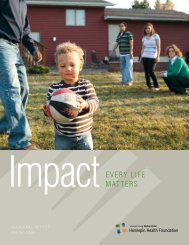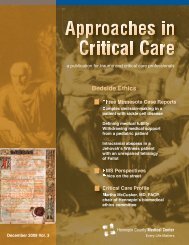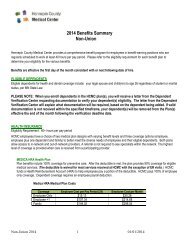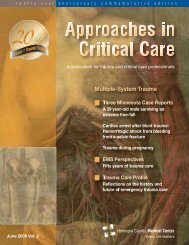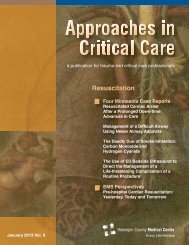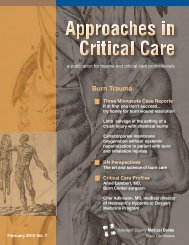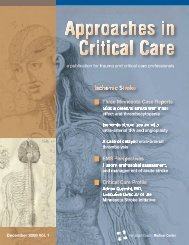Pediatric Trauma - Hennepin County Medical Center
Pediatric Trauma - Hennepin County Medical Center
Pediatric Trauma - Hennepin County Medical Center
Create successful ePaper yourself
Turn your PDF publications into a flip-book with our unique Google optimized e-Paper software.
Technology in Critical Care<br />
Figure Two (a-left):<br />
Normal dose technique<br />
demonstrates a stone in<br />
lower pole of right<br />
kidney. Low dose<br />
technique used on<br />
follow-up scan (b-right)<br />
demonstrated the same<br />
stone with about 20%<br />
the radiation dose from<br />
standard technique.<br />
1. Significant errors in measurement of low-level<br />
radiation doses.<br />
2. Significant errors in the estimation of effective<br />
dose, which is calculated from a regularly<br />
updated conversion factor.<br />
3. Biological plausibility. The biological effects of<br />
radiation decreases as dose decreases, and<br />
DNA repair and elimination of defective cells by<br />
death is a dynamic process.<br />
4. Uncertainty regarding linear-no-threshold model.<br />
5. Non-transferability of the risks and mortality from<br />
radiation. Most medical doses are delivered to a<br />
smaller and more elderly segment of the US<br />
population, but the risks are extrapolated to the<br />
general population.<br />
Radiation risks therefore must be taken in the<br />
appropriate context. If the estimated lifetime number<br />
of deaths from a single CT scan with a dose of 10<br />
mCi is indeed 0.5 per 1000, the estimated lifetime<br />
number of deaths in the same group of individuals<br />
from a lightning strike is 0.0 13 , and from drowning is<br />
0.9. Similarly, the death rate from motor vehicle<br />
accident is 11.9 15 . This does not dissuade most<br />
Americans from driving! Similarly, while the dose<br />
from a head CT is the same as about 20 chest<br />
x-rays, this is still significantly less than a year of<br />
background radiation.<br />
Primum non Nocere<br />
Measurement and quantification of risks from CT<br />
radiation form a fascinating and often controversial<br />
topic, with strong feelings on all sides. Above all, it is<br />
our responsibility as physicians to make sure our<br />
patients are not harmed. With this in mind, any<br />
radiation dose should be assumed to be potentially<br />
harmful, and careful risk-benefit analysis should be<br />
performed. This is particularly important with children,<br />
who are more vulnerable because of longer expected<br />
life spans and more radiation-sensitive body tissues.<br />
At the same time, it would be unconscionable to<br />
deny a patient the benefits from a CT scan that is<br />
appropriately indicated and optimally performed.<br />
What can be done?<br />
Justification: A CT scan should be performed only<br />
when there is the potential of clear benefit. In other<br />
words, the risk of not performing the examination<br />
must exceed the potential risks. A classic situation is<br />
following high-speed trauma, where the risk of not<br />
performing at CT scan includes missing life-threatening<br />
internal organ injury or aortic injury. This clearly exceeds<br />
potential risk of inducing neoplasm later in life.<br />
In most situations, the risk /benefit ratio is more<br />
difficult to evaluate, and individual physician<br />
judgment is paramount. There are many resources<br />
available to assist physicians in making this<br />
judgment. For example, the American College of<br />
Radiology has provided evidence-based guidelines<br />
for appropriate imaging tests 16 . Discussion between<br />
radiologists and physicians, especially physicians-intraining,<br />
clearly helps in the decision-making process<br />
and in tailoring the exam to answer the clinical<br />
question. Decision support systems integrated into<br />
electronic medical systems may also be helpful. It<br />
has been reported that 30% or more of CT scans<br />
currently performed may be unnecessary. This<br />
number must be reduced 17 .<br />
Optimization: Careful attention to technique can<br />
significantly reduce radiation dose. This includes<br />
standardizing protocols, reducing multiple series<br />
within each examination (avoiding "protocol creep"),<br />
implementing dose reduction strategies, and limiting<br />
scanning to part of interest (avoiding "scan creep").<br />
The Society for <strong>Pediatric</strong> Radiology offers very useful<br />
online information regarding tailoring exams in<br />
children, as part of its "image gently" program 18 .<br />
Of late, all CT vendors have introduced numerous<br />
dose reduction techniques. These differ among<br />
vendors, usually involve some form of dose<br />
modulation tailored to the patient body habitus, and<br />
are quite effective in reducing radiation dose while<br />
keeping image quality adequate. In addition, there<br />
are several situations where a low-dose exam with<br />
noisier (grainier, less pleasing) images is appropriate.<br />
In patients with kidney stones, the low-dose<br />
technique takes advantage of inherent contrast<br />
between the stone and surrounding tissues and<br />
produces images of diagnostic quality (Figure Two).<br />
Similarly, low-dose technique may be utilized in<br />
patients with lung nodules for follow-up.<br />
14 | Approaches in Critical Care | June 2011



